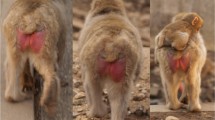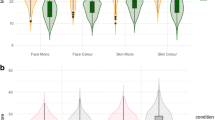Abstract
Various animal species have evolved a sexual communication system with females displaying and males discriminating information about the timing of ovulation through sexual signals. More research is now investigating the potential ovulatory signalling function of female red skin colour in human and non-human primates. However, to date, it is still challenging to draft satisfying hypotheses about the evolution and function of the female red skin colour, due to methodological discrepancies between human and non-human primate studies. The present study used a within-individual design and objective methods to analyse the relationship between fine-scale variation in cheek and lip colour (luminance and redness) and the estimated day of ovulation in 15 cycling women. I found weak evidence that intra-cycle variation in lip luminance only may be less modulated by inter-individual variation, with lips getting slightly darker around ovulation. However, day to day variation in lip luminance is likely imperceptible, meaning that lip luminance may not act as an ovulatory signal in humans. This study adds to the growing research and discussion on the role and evolution of the female red skin colour of human and non-human primates in the context of sexual signalling and mate attraction.
Significance statement
In human and non-human primates, red skin and red ornaments are attractive for both sexes and often associated with mating and fertility. While female red skin colour can be informative about the reproductive status and thus influences mating strategies in some primate species, it is not clear if humans share with non-human primates a colourful trait of ovulation. This study shows a weak relationship between lip luminance only and the timing of ovulation. This study adds to the growing research and discussion on the role and evolution of the female red skin colour of human and non-human primates in the context of sexual signalling and mate attraction.


Similar content being viewed by others
Data availability
The data set generated and analysed during the current study is available in the supplementary material.
References
Bao AM, Liu RY, van Someren E, Hofman MA, Cao YX, Zhou JN (2003) Diurnal rhythm of free estradiol during the menstrual cycle. Eur J Endocrinol 148:227–232. https://doi.org/10.1530/eje.0.1480227
Bartoń K (2017) MuMIn: multi-model inference. R package version 1.40.0, https://CRAN.R-project.org/package=MuMIn
Bates D, Mächler M, Bolker B, Walker S (2015) Fitting linear mixed-effects models using lme4. J Stat Softw 67:1–48. https://doi.org/10.18637/jss.v067.i01
Bergman TJ, Beehner JC (2008) A simple method for measuring colour in wild animals: validation and use on chest patch colour in geladas (Theropithecus gelada). Biol J Linn Soc 94:231–240. https://doi.org/10.1111/j.1095-8312.2008.00981.x
Brainard DH (2003) Color appearance and color difference specification. In: Shevell S (ed) The science of color, 2nd edn. Elsevier, Amsterdam, pp 191–216
Burnham KP, Anderson DR, Huyvaert KP (2011) AIC model selection and multimodel inference in behavioral ecology: some background, observations, and comparisons. Behav Ecol Sociobiol 65:23–35. https://doi.org/10.1007/s00265-010-1029-6
Burriss RP, Troscianko J, Lovell PG, Fulford AJC, Stevens M, Quigley R, Payne J, Saxton TK, Rowland HM (2015) Changes in women’s facial skin color over the ovulatory cycle are not detectable by the human visual system. PLoS One 10:e0130093. https://doi.org/10.1371/journal.pone.0130093
Campbell C (2007) Primate sexuality and reproduction. In: Campbell CJ, Fuentes A, MacKinnon KC (eds) Primates in perspective. Oxford University Press, New York, pp 423–437
Crouzet C, Fournier H, Papon X, Hentati N, Cronier P, Mercier P (1998) Anatomy of the arterial vascularization of the lips. Surg Radiol Anat 20:273–278. https://doi.org/10.1007/BF01628490
Dixson AF (2012) Primate sexuality: comparative studies of the prosimians, monkeys, apes and human beings, 2nd edn. Oxford University Press, New York
Dubuc C, Brent LJN, Accamando AK, Gerald MS, MacLarnon A, Semple S, Heistermann M, Engelhardt A (2009) Sexual skin color contains information about the timing of the fertile phase in free-ranging Macaca mulatta. Int J Primatol 30:777–789. https://doi.org/10.1007/s10764-009-9369-7
Dubuc C, Winters S, Allen WL, Brent LJN, Cascio J, Maestripieri D, Ruiz-Lambides AV, Widdig A, Higham JP (2014) Sexually selected skin colour is heritable and related to fecundity in a non-human primate. Proc R Soc B 281:20141602. https://doi.org/10.1098/rspb.2014.1602
Fitzpatrick CL, Servedio MR (2018) The evolution of male mate choice and female ornamentation: a review of mathematical models. Curr Zool 64:323–333. https://doi.org/10.1093/cz/zoy029
Galef BG (1983) Costs and benefits of mammalian reproduction. In: Rosenblum LA, Moltz H (eds) Symbiosis in parent-offspring interactions. Springer US, Boston, pp 249–278
Gittleman JL, Thompson SD (1988) Energy allocation in mammalian reproduction. Integr Comp Biol 28:863–875. https://doi.org/10.1093/icb/28.3.863
Hahn AC, Whitehead RD, Albrecht M, Lefevre CE, Perrett DI (2012) Hot or not? Thermal reactions to social contact. Biol Lett 8:864–867. rsbl20120338. https://doi.org/10.1098/rsbl.2012.0338
Harrison XA, Donaldson L, Correa-Cano ME, Evans J, Fisher DN, Goodwin CED, Robinson BS, Hodgson DJ, Inger R (2018) A brief introduction to mixed effects modelling and multi-model inference in ecology. PeerJ 6:e4794. https://doi.org/10.7717/peerj.4794
Hartig F (2020) DHARMa: residual diagnostics for hierarchical (multi-level/mixed) regression models, https://CRAN.R-project.org/package=DHARMa
Higham JP, Winters S (2015) Color and mate choice in non-human animals. In: Elliot A, Fairchild M, Franklin A (eds) Handbook of color psychology. Cambridge University Press, Cambridge, pp 502–530. https://doi.org/10.1017/CBO9781107337930.025
Higham JP, Brent LJN, Dubuc C, Accamando AK, Engelhardt A, Gerald MS, Heistermann M, Stevens M (2010) Color signal information content and the eye of the beholder: a case study in the rhesus macaque. Behav Ecol 21:739–746. https://doi.org/10.1093/beheco/arq047
Hodges JK, Heistermann M (2011) Field endocrinology: monitoring hormonal changes in free-ranging primates. In: Setchell JM, Curtis DJ (eds) Field and laboratory methods in primatology: a practical guide. Cambridge University Press, UK, pp 353–370
Kuznetsova A, Brockhoff PB, Christensen RHB (2017) lmerTest package: tests in linear mixed effects models. J Stat Softw 82:1–26. https://doi.org/10.18637/jss.v082.i13
Nakagawa S, Schielzeth H (2013) A general and simple method for obtaining R2 from generalized linear mixed-effects models. Methods Ecol Evol 4:133–142. https://doi.org/10.1111/j.2041-210x.2012.00261.x
Oberzaucher E, Katina S, Schmehl SF, Holzleitner IJ, Mehu-Blantar I, Grammer K (2012) The myth of hidden ovulation: shape and texture changes in the face during the menstrual cycle. J Evol Psychol 10:163–175. https://doi.org/10.1556/JEP.10.2012.4.1
Pazda AD, Thorstenson CA, Elliot AJ, Perrett DI (2016) Women’s facial redness increases their perceived attractiveness: mediation through perceived healthiness. Perception 45:739–754. https://doi.org/10.1177/0301006616633386
Pelletier G, Ren L (2004) Localization of sex steroid receptors in human skin. Histol Histopathol 19:629–636. https://doi.org/10.14670/HH-19.629
R Core Team (2019) R: A language and environment for statistical computing. R Foundation for Statistical Computing, Vienna, Austria, https://www.R-project.org/
Re DE, Whitehead RD, Xiao D, Perrett DI (2011) Oxygenated-blood colour change thresholds for perceived facial redness, health, and attractiveness. PLoS One 6:e17859. https://doi.org/10.1371/journal.pone.0017859
Rhodes L, Argersinger ME, Gantert LT, Friscino BH, Hom G, Pikounis B, Hess DL, Rhodes WL (1997) Effects of administration of testosterone, dihydrotestosterone, oestrogen and fadrozole, an aromatase inhibitor, on sex skin colour in intact male rhesus macaques. J Reprod Fertil 111:51–57. https://doi.org/10.1530/jrf.0.1110051
Rigaill L, MacIntosh AJJ, Higham JP, Winters S, Shimizu K, Mouri K, Furuichi T, Garcia C (2015) Multimodal advertisement of pregnancy in free-ranging female Japanese macaques (Macaca fuscata). PLoS One 10:e0135127. https://doi.org/10.1371/journal.pone.0135127
Rigaill L, Higham JP, Winters S, Garcia C (2019) The redder the better? Information content of red skin coloration in female Japanese macaques. Behav Ecol Sociobiol 73:103. https://doi.org/10.1007/s00265-019-2712-x
Rooker K, Gavrilets S (2018) On the evolution of visual female sexual signalling. Proc R Soc B 285:20172875. https://doi.org/10.1098/rspb.2017.2875
Rowland HM, Burriss RP (2017) Human colour in mate choice and competition. Philos Trans R Soc B 372:20160350. https://doi.org/10.1098/rstb.2016.0350
Samson N, Fink B, Matts P (2011) Does a woman’s skin color indicate her fertility level? Preliminary findings. Swiss J Psychol 70:199–202. https://doi.org/10.1024/1421-0185/a000057
Setchell JM, Wickings EJ, Knapp LA (2006) Signal content of red facial coloration in female mandrills (Mandrillus sphinx). Proc R Soc Lond B 273:2395–2400. https://doi.org/10.1098/rspb.2006.3573
Stephen ID, McKeegan AM (2010) Lip colour affects perceived sex typicality and attractiveness of human faces. Perception 39:1104–1110. https://doi.org/10.1068/p6730
Stevens M, Stoddard MC, Higham JP (2009) Studying primate color: towards visual system-dependent methods. Int J Primatol 30:893–917. https://doi.org/10.1007/s10764-009-9356-z
Symonds MRE, Moussalli A (2011) A brief guide to model selection, multimodel inference and model averaging in behavioural ecology using Akaike’s information criterion. Behav Ecol Sociobiol 65:13–21. https://doi.org/10.1007/s00265-010-1037-6
Thornton MJ (2002) The biological actions of estrogens on skin. Exp Dermatol 11:487–502. https://doi.org/10.1034/j.1600-0625.2002.110601.x
Thornton MJ, Taylor AH, Mulligan K, Al-Azzawi F, Lyon CC, O’Driscoll J, Messenger AG (2003) The distribution of estrogen receptor β is distinct to that of estrogen receptor α and the androgen receptor in human skin and the pilosebaceous unit. J Invest Dermatol 8:100–103. https://doi.org/10.1046/j.1523-1747.2003.12181.x
Thorstenson CA, Pazda AD, Elliot AJ, Perrett DI (2017) Facial redness increases men’s perceived healthiness and attractiveness. Perception 46:650–664. https://doi.org/10.1177/0301006616680124
Třebický V, Fialová J, Kleisner K, Havlíček J (2016) Focal length affects depicted shape and perception of facial images. PLoS One 11:e0149313. https://doi.org/10.1371/journal.pone.0149313
Vorobyev M, Gumbert A, Kunze J, Giurfa M, Menzel R (1997) Flowers through insect eyes. Isr J Plant Sci 45:93–101. https://doi.org/10.1080/07929978.1997.10676676
White T, Dalrymple R, Noble D, O’Hanlon J, Zurek D, Umbers K (2015) Reproducible research in the study of biological coloration. Anim Behav 105:51–57. https://doi.org/10.1016/j.anbehav.2015.05.007
Young SG (2015) The effect of red on male perceptions of female attractiveness: moderation by baseline attractiveness of female faces. Eur J Soc Psychol 45:146–151. https://doi.org/10.1002/ejsp.2098
Acknowledgements
I acknowledge the Human Research Ethics Committee of Kyoto University Primate Research Institute for permission to conduct my research. I would like to sincerely thank Christof Neumann for his insightful comments on the study and his valuable advice with statistical analyses. I am grateful to the two anonymous reviewers, the handling editor Michel Raymond, Julie Duboscq, Cécile Garcia, and Andrew MacIntosh for their comments on earlier versions of the manuscript, and to Keiko Mouri for her general support in the lab.
Funding
This work was supported by the Japanese Society for the Promotion of Science (project 18H05810 JSPS).
Author information
Authors and Affiliations
Corresponding author
Ethics declarations
Conflict of interest
The author declares that she has no conflict of interest.
Ethical approval
This study was approved by the Human Research Ethics Committee of the Kyoto University Primate Research Institute with the spirit of the Helsinki Declaration of 1975, as revised in 2000 (KUPRI, project number 2017-13). All participants signed a written agreement concerning their participation in the study, confidentiality, and the use of their photographs for research purposes and illustrations. Participants received financial compensation in return for their participation (5,000 JPY ~ 45 USD).
Additional information
Communicated by M. Raymond
Publisher’s note
Springer Nature remains neutral with regard to jurisdictional claims in published maps and institutional affiliations.
Rights and permissions
About this article
Cite this article
Rigaill, L. Fine-scale variation in lip and cheek colour according to the timing of ovulation in women. Behav Ecol Sociobiol 74, 71 (2020). https://doi.org/10.1007/s00265-020-02851-y
Received:
Revised:
Accepted:
Published:
DOI: https://doi.org/10.1007/s00265-020-02851-y




